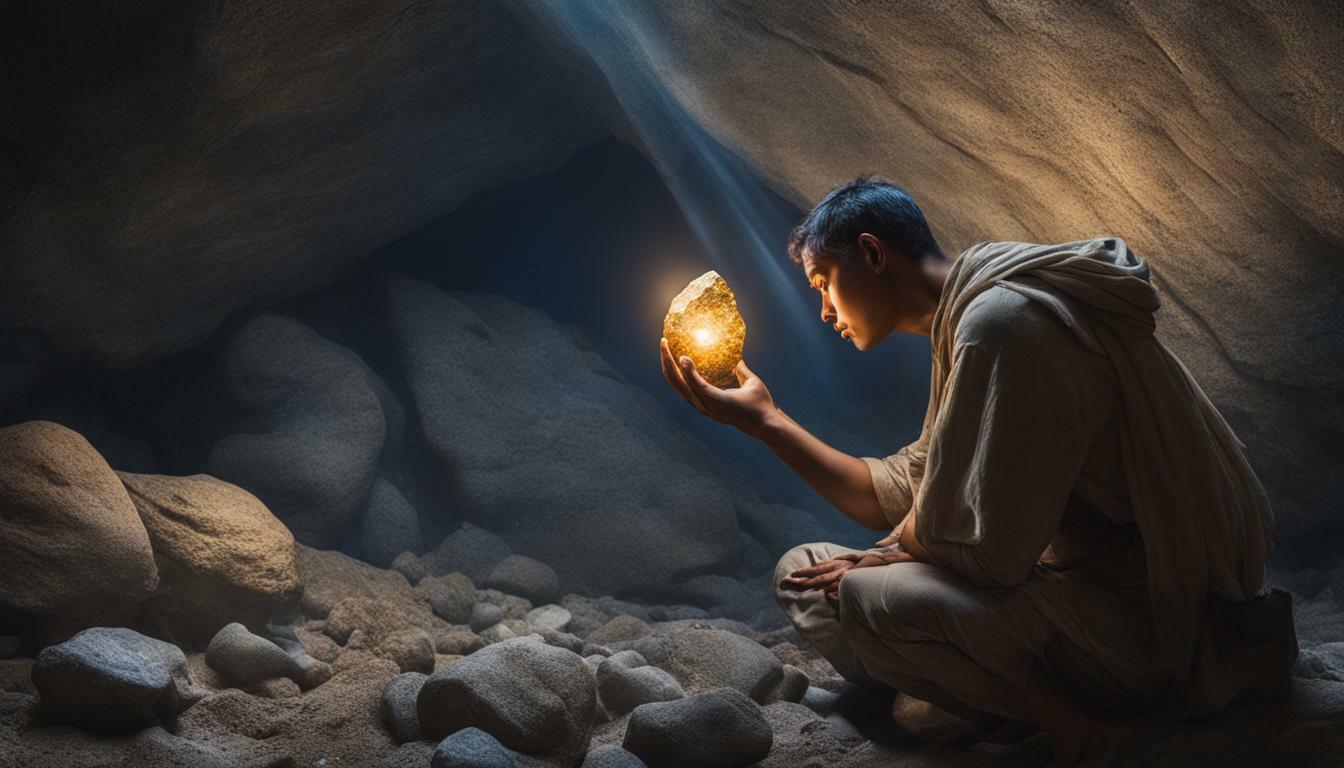Are you curious about how to tell if a rock has crystals inside? You’ve come to the right place! In this section, we will explore the various indicators that can help you determine if a rock contains crystals. By understanding these signs, you’ll be able to unveil nature’s hidden gems and identify rocks with crystal formations.
Key Takeaways:
- To determine if a rock has crystals, consider its locality, as geodes are often formed in specific geological settings such as volcanic ash beds or carbonate deposits.
- Geodes have a round shape and a bumpy texture on the outside. Shaking a geode may produce a sound or rattle, indicating an empty space inside.
- Tapping the rock and listening for a hollow sound can be a good sign that it may contain crystals. A lighter-than-expected rock could also suggest the presence of crystals.
- To confirm if a rock is a geode, it can be cracked open using a hammer or other tools. Identifying the minerals inside the geode can help determine the type of crystal it contains.
Signs of Crystals in Rocks
Before cracking open a rock, there are several signs you can look for to determine if it contains crystals. By analyzing rocks for these signs, you can get a good idea of whether it’s worth further investigation or not.
- Locality: The geological setting of the rock is an important factor. Geodes, which often contain crystal formations, are typically found in specific areas such as volcanic ash beds or carbonate deposits.
- Shape and Texture: Geodes usually have a round shape and a bumpy texture on the outside surface. These unique characteristics can be a clue that crystals may be present within.
- Sound: When shaken, geodes may produce a sound or rattle. This indicates that there is an empty space inside the rock, which can be an indication of crystals.
- Tapping: Tapping the rock and listening for a hollow sound is another sign to look out for. If the rock sounds hollow, it suggests that there might be an internal cavity containing crystals.
- Weight: If the rock feels lighter than expected, it could mean that it’s hollow and contains crystals. This can be a good indicator to further investigate the rock.
While these signs can help you identify rocks that may contain crystals, it’s important to note that they are not definitive proof. To confirm the presence of crystals, you can proceed by cracking open the rock using appropriate tools such as a hammer or chisel.
Cracking Open Rocks: Confirming Crystal Presence
Cracking open a rock is often the most reliable way to determine if it contains crystals. By carefully using a hammer or chisel, you can expose the hidden treasures within. However, it’s essential to use caution and proper techniques to avoid damaging the crystals or yourself.
Once you’ve cracked open the rock, it’s important to identify the minerals or crystals inside. This can be done by examining their color, shape, and other physical properties. Understanding the characteristics of different crystals will help you identify the type of crystal formation you’ve discovered.
| Crystal | Color | Shape | Physical Properties |
|---|---|---|---|
| Quartz | Clear, white, pink, purple, etc. | Hexagonal prisms or pyramids | Hardness: 7, transparent, piezoelectric |
| Amethyst | Purple | Hexagonal prisms or pyramids | Hardness: 7, transparent, quartz variety |
| Citrine | Yellow to golden-brown | Hexagonal prisms or pyramids | Hardness: 7, transparent, quartz variety |
By following these signs and techniques, you can embark on an exciting journey of discovering nature’s hidden crystals. Remember to always handle rocks and crystals with care and respect, embracing the beauty and wonder they hold.
How to Identify Crystals in Rocks
Once you’ve identified a rock that shows signs of containing crystals, it’s important to know how to identify the specific crystal formations within it. Crystal detection in rocks can be a fascinating and rewarding process, allowing you to uncover the beauty and uniqueness of each crystal. By understanding the characteristics and formations of different crystals, you’ll be able to confidently identify them within rocks.
One effective way to identify crystals in rocks is to examine their physical characteristics. Rock crystal characteristics can vary greatly, depending on the type of crystal present. Some crystals may have distinct shapes or formations, such as the cubic structure of pyrite or the hexagonal structure of quartz. By comparing the physical features of the crystal you wish to identify with known crystal formations, you can narrow down the possibilities and determine its name.
Another method of crystal identification is to examine crystal inclusions within rocks. Crystal inclusions refer to the small mineral fragments or impurities that are trapped within a crystal. These inclusions can provide valuable clues about the type of crystal present. By carefully observing the inclusions under a magnifying glass or microscope, you can identify unique patterns, colors, or textures that can help with crystal identification.
| Crystal Formation | Characteristics | Inclusions |
|---|---|---|
| Quartz | Hexagonal shape, glass-like transparency | Inclusions of other minerals like rutile or tourmaline |
| Amethyst | Purple color, translucent to transparent | Inclusions of iron or other trace elements |
| Calcite | Rhombohedral shape, various colors | Inclusions of other minerals like sulfur or dolomite |
In addition to physical characteristics and inclusions, crystal identification can also involve conducting various tests. These tests can include observing the crystal’s hardness, color streak, or reaction to acid. By using these techniques, you can gather more information about the crystal’s properties and narrow down its identity.
Summary:
- Identifying crystals within rocks requires knowledge of crystal formations and characteristics.
- Physical characteristics, such as shape, transparency, and color, can help identify specific crystals.
- Examining crystal inclusions can provide valuable clues about the type of crystal present.
- Conducting tests, such as hardness and acid reactions, can further aid in crystal identification.
By combining these methods and techniques, you’ll be able to confidently identify crystals within rocks and appreciate their unique beauty. Keep exploring, and may your crystal identification journey be filled with exciting discoveries!
Cracking Open Rocks: Confirming Crystal Presence
Cracking open a rock is often necessary to confirm the presence of crystals and explore their beauty. While it may sound daunting, with the right tools and techniques, you can uncover the hidden treasures within.
Before you begin, make sure you have a safety goggles to protect your eyes from flying debris. Start by placing the rock on a sturdy surface, such as a concrete floor or a hard rock. Use a chisel and hammer to carefully strike the rock along its natural cracks or seams. Apply steady pressure and controlled strikes to avoid shattering the entire rock.
As you gently tap the rock, listen for any changes in sound. A hollow sound can indicate an empty cavity, which is a good indication of crystal presence. Continue striking until the rock cracks open, revealing its interior. Take caution when handling the broken pieces, as they may be sharp.
Once the rock is open, carefully examine the inner surfaces for any signs of crystals. Look for sparkling formations, vibrant colors, or unique patterns. Make sure to note the shape, size, and texture of the crystals. You can use a magnifying glass or a microscope to get a closer look at the intricate details.
To help with identification, consult a crystal identification guide or seek the expertise of a geologist who can analyze the minerals present. By comparing the characteristics of the crystals you found with known crystal formations, you can gain a better understanding of the rock’s composition and the type of crystals it contains.
| Tips for Cracking Open Rocks: |
|---|
| 1. Always wear safety goggles when breaking rocks to protect your eyes. |
| 2. Use a chisel and hammer to strike along natural cracks or seams in the rock. |
| 3. Apply steady pressure and controlled strikes to avoid shattering the entire rock. |
| 4. Listen for a hollow sound while tapping the rock, indicating an empty cavity. |
| 5. Examine the broken pieces for sparkling formations, vibrant colors, or unique patterns. |
Conclusion
Identifying crystals in rocks can be an exciting and rewarding endeavor, and by following the steps outlined in this guide, you’ll become skilled at recognizing the signs and characteristics of crystals within rocks. Whether you’re a rock enthusiast, a crystal collector, or simply curious about the hidden treasures of nature, understanding how to tell if a rock has crystals in it is a valuable skill.
To begin your crystal identification journey, it’s essential to consider the locality of the rock. Geodes, which often contain crystals, are typically formed in specific geological settings such as volcanic ash beds or carbonate deposits. These round rocks with a bumpy texture on the outside can be a promising sign of crystal presence.
When examining a rock, there are a few indicators that can help you determine if it contains crystals. Shaking the rock and listening for a sound or rattle can indicate an empty space within, suggesting the presence of crystals. Tapping the rock and listening for a hollow sound is another positive sign. If the rock feels unexpectedly light, it may be hollow and contain crystals.
Cracking open a rock can provide definitive confirmation of crystal presence. By using appropriate tools like a hammer, you can carefully break the rock and reveal the hidden crystals within. Identifying the minerals inside the geode will also provide valuable insights into the type of crystals it contains, allowing you to further explore and appreciate the beauty of nature’s creations.
What Are the Signs of Authentic Crystals?
When it comes to telling real crystals apart, there are a few key signs to look out for. First, check for natural imperfections like inclusions, which are small internal fractures. Real crystals also tend to have a cold touch and a unique energy when held. Additionally, their colors should be vibrant and distinct, while glassy or plastic-like appearance might indicate fake crystals. Finally, reputable sellers and certified gemologists can provide invaluable guidance in identifying authentic crystals.
FAQ
Q: How can I tell if a rock has crystals inside?
A: There are several indicators to look for. Firstly, it’s important to know the locality, as geodes are formed in specific geological settings such as volcanic ash beds or carbonate deposits. Geodes are round in shape and have a bumpy texture on the outside. When shaken, geodes may make a sound or rattle, indicating an empty space inside. Additionally, tapping the rock and listening for a hollow sound can be a good sign. If the rock is lighter than expected, it may be hollow and contain crystals. To confirm if it is a geode, the rock can be cracked open using a hammer or other tools. Finally, identifying the minerals inside the geode can help to determine what type of crystal it contains.
Q: What are the signs of crystals in rocks?
A: The signs of crystals in rocks include round and bumpy shapes, shaking sounds or rattling, a hollow sound when tapped, and a lighter weight than expected. These indicators suggest the presence of a geode that may contain crystals.
Q: How can I identify crystals in rocks?
A: To identify crystals in rocks, you can examine their formations and characteristics. Look for round and bumpy shapes, listen for shaking sounds or rattling, tap the rock and listen for a hollow sound, and note if the rock feels lighter than expected. Cracking open the rock can also help confirm the presence of crystals.
Q: How do I confirm crystal presence by cracking open rocks?
A: To confirm crystal presence, you can crack open rocks using a hammer or other tools. Follow proper techniques and safety precautions when doing so. By cracking open the rock, you’ll be able to expose the hidden crystals within and gain a deeper understanding of their characteristics.








